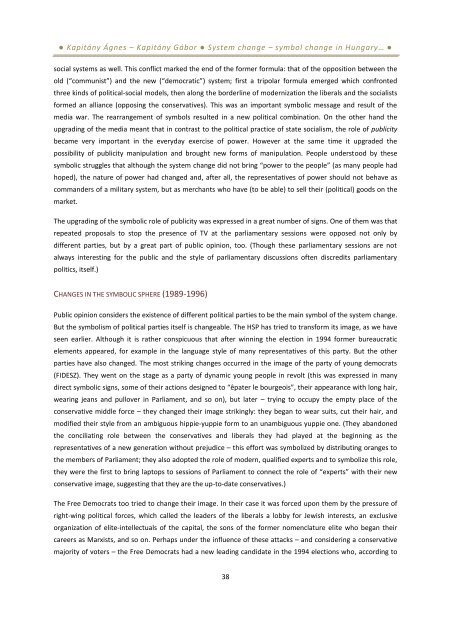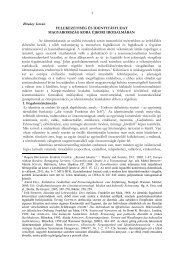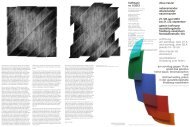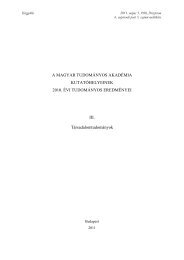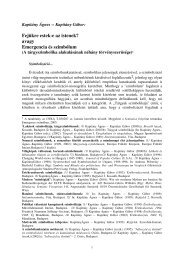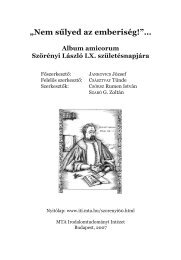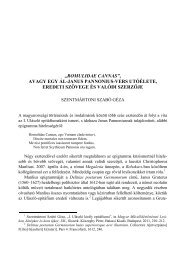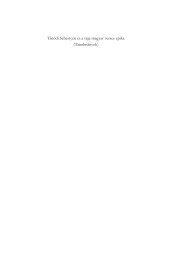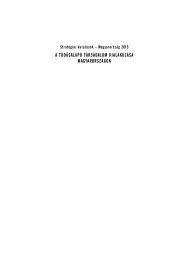symbolic elements of everyday culture - MTA Szociológiai ...
symbolic elements of everyday culture - MTA Szociológiai ...
symbolic elements of everyday culture - MTA Szociológiai ...
Create successful ePaper yourself
Turn your PDF publications into a flip-book with our unique Google optimized e-Paper software.
● Kapitány Ágnes – Kapitány Gábor ● System change – symbol change in Hungary… ●<br />
social systems as well. This conflict marked the end <strong>of</strong> the former formula: that <strong>of</strong> the opposition between the<br />
old (“communist”) and the new (“democratic”) system; first a tripolar formula emerged which confronted<br />
three kinds <strong>of</strong> political-social models, then along the borderline <strong>of</strong> modernization the liberals and the socialists<br />
formed an alliance (opposing the conservatives). This was an important <strong>symbolic</strong> message and result <strong>of</strong> the<br />
media war. The rearrangement <strong>of</strong> symbols resulted in a new political combination. On the other hand the<br />
upgrading <strong>of</strong> the media meant that in contrast to the political practice <strong>of</strong> state socialism, the role <strong>of</strong> publicity<br />
became very important in the <strong>everyday</strong> exercise <strong>of</strong> power. However at the same time it upgraded the<br />
possibility <strong>of</strong> publicity manipulation and brought new forms <strong>of</strong> manipulation. People understood by these<br />
<strong>symbolic</strong> struggles that although the system change did not bring “power to the people” (as many people had<br />
hoped), the nature <strong>of</strong> power had changed and, after all, the representatives <strong>of</strong> power should not behave as<br />
commanders <strong>of</strong> a military system, but as merchants who have (to be able) to sell their (political) goods on the<br />
market.<br />
The upgrading <strong>of</strong> the <strong>symbolic</strong> role <strong>of</strong> publicity was expressed in a great number <strong>of</strong> signs. One <strong>of</strong> them was that<br />
repeated proposals to stop the presence <strong>of</strong> TV at the parliamentary sessions were opposed not only by<br />
different parties, but by a great part <strong>of</strong> public opinion, too. (Though these parliamentary sessions are not<br />
always interesting for the public and the style <strong>of</strong> parliamentary discussions <strong>of</strong>ten discredits parliamentary<br />
politics, itself.)<br />
CHANGES IN THE SYMBOLIC SPHERE (1989-1996)<br />
Public opinion considers the existence <strong>of</strong> different political parties to be the main symbol <strong>of</strong> the system change.<br />
But the symbolism <strong>of</strong> political parties itself is changeable. The HSP has tried to transform its image, as we have<br />
seen earlier. Although it is rather conspicuous that after winning the election in 1994 former bureaucratic<br />
<strong>elements</strong> appeared, for example in the language style <strong>of</strong> many representatives <strong>of</strong> this party. But the other<br />
parties have also changed. The most striking changes occurred in the image <strong>of</strong> the party <strong>of</strong> young democrats<br />
(FIDESZ). They went on the stage as a party <strong>of</strong> dynamic young people in revolt (this was expressed in many<br />
direct <strong>symbolic</strong> signs, some <strong>of</strong> their actions designed to “êpater le bourgeois”, their appearance with long hair,<br />
wearing jeans and pullover in Parliament, and so on), but later – trying to occupy the empty place <strong>of</strong> the<br />
conservative middle force – they changed their image strikingly: they began to wear suits, cut their hair, and<br />
modified their style from an ambiguous hippie-yuppie form to an unambiguous yuppie one. (They abandoned<br />
the conciliating role between the conservatives and liberals they had played at the beginning as the<br />
representatives <strong>of</strong> a new generation without prejudice – this effort was symbolized by distributing oranges to<br />
the members <strong>of</strong> Parliament; they also adopted the role <strong>of</strong> modern, qualified experts and to symbolize this role,<br />
they were the first to bring laptops to sessions <strong>of</strong> Parliament to connect the role <strong>of</strong> “experts” with their new<br />
conservative image, suggesting that they are the up-to-date conservatives.)<br />
The Free Democrats too tried to change their image. In their case it was forced upon them by the pressure <strong>of</strong><br />
right-wing political forces, which called the leaders <strong>of</strong> the liberals a lobby for Jewish interests, an exclusive<br />
organization <strong>of</strong> elite-intellectuals <strong>of</strong> the capital, the sons <strong>of</strong> the former nomenclature elite who began their<br />
careers as Marxists, and so on. Perhaps under the influence <strong>of</strong> these attacks – and considering a conservative<br />
majority <strong>of</strong> voters – the Free Democrats had a new leading candidate in the 1994 elections who, according to<br />
38


